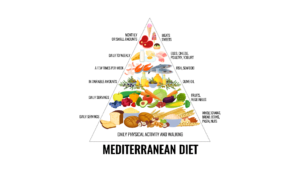Ever felt a flutter or a ‘butterfly’ feeling in your tummy, like before a presentation or exam? Maybe your mouth has salivated when you have smelt something delicious! Well, that was your mind-gut connection in play.
Your brain and gut are in constant connection with one another via the vagus nerve the longest nerve in the body. This bidirectional link is between your central nervous system (CNS), your enteric nervous system (ENS), hypothalamic-pituitary-adrenal (HPA) axis and let’s not forget your gut microbiome also plays a role! This link is always communicating with each other, playing a huge role in your digestion, immune, hormonal and nervous systems.
Why does stress affect the gut?
When you are stressed, you go out of Parasympathetic Nervous System (PNS) “rest and digest” into the Sympathetic Nervous System (SNS) “flight or fight”. This could show up as a quick bathroom stop before your big presentation or a nervous poo before you have an interview. After the event is over your body will come back to a natural balance of PNS, this process is healthy and does happen regularly, and the important factor in helping us go back to balance is resilience.
In prolonged chronic stressful states this may not go back, and you may get stuck in the flight or fight response leading to gut symptoms like bloating, reflux, diarrhoea, constipation, IBS, poor sleep, mood disorder, anxiety, and fatigue.
Why is it important to go back into PNS? Well, the PNS plays a role in these very important functions in the body:
- Reduces heart rate, increases vasodilation (relaxing of the smooth muscles in the blood vessels).
- Stimulates the salivary glands to start the digestion process.
- Increases motility in the stomach and intestines.
- Helps the gallbladder to release bile to aid in digestion.
- Stimulates the pancreas to release digestive enzymes and insulin.
So, you can see if you were stuck in a chronic stressful state, it would have a huge impact on your digestive function and gut motility!
What does my microbiome have to do with my mood?
Did you know that your gut bugs aka your microbiome play a role in the connection with the vagus nerve and your gut-brain axis?
The vagus nerve is constantly sampling the microbiome and sending signals from the gut back to the brain. If you have an imbalance in your gut microbiome like inflammation, poor microbiome diversity and gut dysbiosis (overgrowth and imbalance of bad bacteria) you could be negatively affecting not only your gut health but also your mood and stress. A low vagal tone has been shown in patients with IBS and IBD, and these conditions both have a strong link to dysbiosis.
Mood hormones like GABA and 5-HT are metabolites that are produced from probiotic bacteria. These bacteria can also have a positive effect on reducing anxiety and depression.
5 ways to improve your gut-brain axis, vagus nerve and digestive issues!
- Nutrients and herbs to support a healthy stress response
Stress can be greatly impacted by magnesium deficiency. If you are stressed, you increase your excretion of magnesium and if you are low in magnesium, it increases the stress response. So, it’s a catch 22. Your health care practitioner may suggest a practitioner grade good quality well absorbed magnesium to improve your stress response. B vitamins are also a group of nutrients that can support you in times of stress and fatigue.
Adaptogenic herbs are wonderful for supporting the body to adapt to stress. Your practitioner may recommend herbs like Withania, Siberian ginseng and Rhodiola. Also, lavender, passionflower and magnolia can have a positive effect on increasing the calming hormone GABA which will help reduce stress and anxiety.
- Improve your vagal tone!
- Grounding yourself with bare feet on the grass for 5-10 minutes a day.
- Getting outside in nature. Studies have shown that walking in nature can reduce anxiety and depression.
- Daily meditation/mindfulness by using apps like Calm, InsightTimer, Headspace, The Art of Living.
- Box Breathing – inhale for a count of 4, hold for a count of 4, exhale for a count of 4, hold for a count of 4. Repeat as many times as you need.
- Having cold showers, humming, chanting, gargling and yoga are amazing for toning your vagus nerve!
- Get more sleep.
- And move daily.
- Reduce inflammation
Look at limiting and eliminating foods that increase inflammation in the body. Cut down on coffee if you notice that it increases your stress and anxiety. Limit alcohol, reduce refined carbohydrates like processed food and sugary foods.
Avoid unhealthy fats, vegetable/seed oils, deep fried foods, and margarine (eat real butter instead!). These types of fats are high in omega 6 arachidonic acid (ARA) and these increase pro-inflammatory mediators in the body. Instead increase omega 3 fatty acids food that are rich in EPA and DHA and have an anti-inflammatory action in the body. Food like – oily fish (sardines, mackerel and wild salmon), chia seeds, Extra Virgin Olive Oil (EVOO), avocado, nuts & seeds (flaxseeds), coconut oil, hemp seeds, natto and eggs.
Increase foods that contain polyphenols. Polyphenols are natural compounds found in plant food. They are antioxidants that help to reduce oxidative stress in the body and reduce inflammation. There are many foods that are rich in polyphenols like:
- berries
- plums
- black grapes
- black olives
- black tea, green tea and coffee (avoid if it increases your anxiety)
- cocoa
- herbs and spices like ginger, cumin and turmeric
- Support your good gut bugs!
By increasing probiotic and prebiotic foods you can greatly impact the health of your gut and improve your microbiome to have a positive impact on the gut-brain axis.
Probiotics are live microorganisms that have a positive affect on health. They are important for healthy digestion and immune function; they can also have a positive impact on mood. Probiotics like Lactobacillus paracasei Lpc-37™ and Lactobacillus plantarum 299v have been shown to support the HPA axis during times of stress. They also influence the gut-brain axis and reduce cortisol in times of chronic stress and anxiety. It is important when taking a probiotic that you take a strain specific probiotic that specifically meets your health needs.
You can also increase probiotic foods like yoghurt, kefir, kombucha, fermented vegetables like sauerkraut and miso.
Prebiotics help to feed your good gut bugs and help them to thrive. Your microbes in your gut help to digest fibre and by feeding them certain gut loving fibre foods, this will support them to grow and produce Short Chain Fatty Acids (SCFA) which help to reduce inflammation.
Some prebiotic foods to include in your diet are kiwifruit, green bananas, garlic, onions, cabbage, rhubarb, fennel, oats, lentils, cooked and cooled potato.
- Functional microbiome testing
Naturopaths, nutritionists, and other natural health care practitioners can order specific tests to see what is going on in your gut microbiome. It takes out the guess work and can show us areas that need to be addressed. Like what is the state of your gut mucosa lining, is it inflamed, do you have leaky gut or poor digestion? It can also show us if you have dysbiosis like opportunistic bacteria, parasites, and candida. We then want to see the diversity of your microbiome and the health of your good gut bugs. These tests really help to show us where we need to pay attention and can sometimes be such a relief for patients to finally see what is going wrong and how we can make their gut and mind happy again!
It’s important to work with a health care practitioner that can support you and your health holistically to get you to a place of a happy gut and a happy mind!
References:
Neuroanatomy, Parasympathetic Nervous System – StatPearls – NCBI Bookshelf (nih.gov)
Frontiers | The Vagus Nerve at the Interface of the Microbiota-Gut-Brain Axis (frontiersin.org)
Serotonin, tryptophan metabolism and the brain-gut-microbiome axis – ScienceDirect
A New Approach to Managing Mood via the Gut-Brain Axis | Metagenics Institute ANZ











